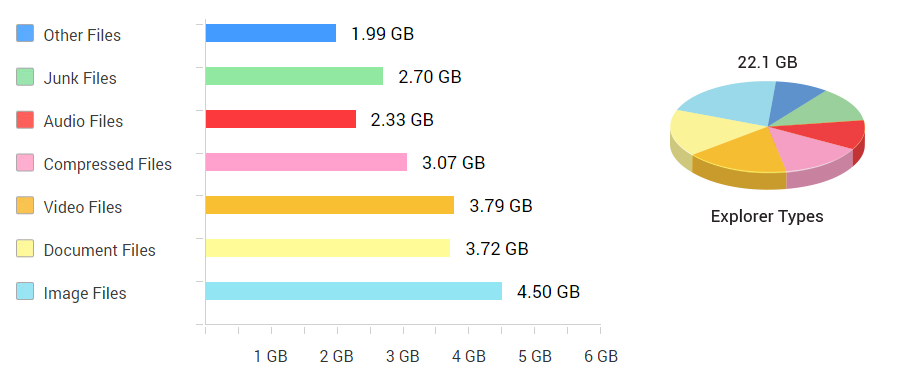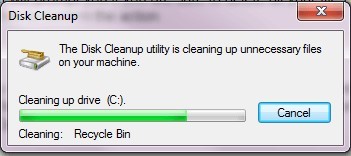Regardless what size your hard disk is, sooner or later, the drive’s free space will get overrun with data and you will get a message that hard disk space is running out. If you are stuck with clogged hard disk and want to desperately reclaim some space, you’ve come to the right place.
We have listed some of the ways to free up disk space on Windows 10, 8 and 7.
Best Ways To Free Up Disk Space On Windows
1. Use The Easy Way – Disk Analyzer Pro
If you want to recover the space on your system and save your time as well, you can take up a third party software. Disk Analyzer Pro is the disk management tool that helps you to manage and recover space on your Windows computer fast and easy. Let’s have the look on the features of the tool:

- It prepares a detailed analysis of disk space consumption grouped by file type, attributes, file size and more.
- It easily searches for unwanted files with search criteria.
- It swiftly finds and deletes junk and temporary files.
- It locates the large files as well as duplicate files and gives you an option to delete them in a window.
2. Empty Recycle Bin
Recycle Bin is the place where all the deleted files are stored before you delete the files permanently. The accumulation of the files in the bin takes up space and clog your hard disk. To clear the space on your hard disk, go to Recycle Bin and select all the files in your Recycle Bin that you want to delete. Right-click and select Delete from the context menu. Click OK to confirm the action when prompted.
3. Use Disk Cleanup
Disk Cleanup is a utility tool that can be used to delete temporary files and unwanted data. To perform the disk cleanup, follow these steps:
- To open Disk Cleanup, type in disk cleanup or to open Run window, press Windows and R key and type cleanmgr.

- The Disk Cleanup window will open asking you to select the drive
- You will get the Disk Cleanup interface asking you to select the drive you want to clean. By default, C is selected.

- Click OK.
- Disk Cleanup will calculate the space that could be recovered with this action.

- You will get the options to remove files from your system to free up space. Select Temporary files (Temp), Temporary Internet Files, Downloaded Program Files, Thumbnails, and Offline web pages.

- Press OK to begin the process.

- Now, you will get a prompt asking if you want to delete all your files permanently. Click on Delete files to confirm the action.

This process will be same for the Windows 7, Windows 8 and Windows 10.
4. Delete Temporary Files
To further delete the unwanted data from your computer, you can delete the temporary files from other programs. To do that, follow these steps:
- Click on My Computer or Computer from Start.
- Go to Local Disk C.

- Once you are in Local Disk C, navigate to this path

\Users\USERNAME\AppData\Local\Temp
Note: Press Windows and R key to open Run Window and type %temp%.
- The file explorer will open with all the temporary files on it.
- Select all the files and press Delete to delete all the files.

This process will be same for the Windows 7, Windows 8 and Windows 10.
5. Turn on Storage Sense
Storage Sense is the feature which is added in Windows 10 after Windows 10 Creators Update. The feature sensibly clears the storage on your hard disk.
To enable it, Go to Settings-> System

Now click Storage-> Storage Sense.
With the feature turned on, Windows will delete unused temporary files and all the deleted files have been in there for 30 days in Recycle Bin.
6. Uninstall Apps
Intentionally or unintentionally, you install applications that you don’t use much which take up unnecessary space on your hard disk. Uninstalling the applications can recover some space on your hard disk. To do that, follow these steps:
- Go to Start and open Control Panel.
- In Control Panel, click Programs.
- You will get Programs and Features, underneath that click on the option, Uninstall a program.
- You will get a list of programs installed on your computer.
- Select the program that you want to uninstall, right click on it and select Uninstall.
- Once the software would be removed, you will get a prompt.
- Do the same for the unwanted programs.
These steps would be same in Windows 7, Windows 8 and Windows 10.
6. Save Files To a Different Drive or Cloud
If you have followed all the steps and still see the drive bar in color red then moving the files to external drive seems to be a good option to recover space on your hard drive. If you don’t have an external drive, then you can use cloud storage to save the data and make some space on your computer.
These are the various ways in which you can free up disk space on Windows 10, Windows 8 and Windows 7.












 Subscribe Now & Never Miss The Latest Tech Updates!
Subscribe Now & Never Miss The Latest Tech Updates!